When schools abruptly closed in the spring due to the COVID-19 pandemic, they quickly found new ways to teach students. But whether it was virtual learning or paper packets, remote learning is not as effective as in-person instruction, state and local educators concede.
Although we won't know how much learning was lost until students are assessed, studies show there could be significant learning gaps.
Students could return to school with a learning loss of 30 percent in reading and more than 50 percent in math as a result of the school closures - nearly a full year behind in math for some grades, according to a Northwest Evaluation Association study.
The Jefferson City School District will use existing assessments, such as iReady for elementary students, to gauge where students are when returning to school, Chief of Learning Shelby Scarbrough said.
"We have made adjustments to our curriculum to include the standards that were missed in the fourth quarter last year and can modify further according to our students' needs," Scarbrough said. "We are confident that we have a plan to make up for lost learning. This will remain top of mind for all of our educators as we head into the 2020-2021 school year."
After visiting with building administrators, faculty and staff, Blair Oaks R-2 School District Superintendent Jim Jones said he thinks students learned the essential concepts needed for the next grade level during the closure.
Blair Oaks administration created priority standards, based on the Missouri Learning Standards, that they focused on in the spring and recently evaluated how well they were addressed.
"Although not all of the curriculum may have been addressed to the same level as in-person learning would have allowed, we feel that we were able to minimize learning loss," he said.
Fewer than 20 students completed paper packets instead of virtual instruction during the closure, Jones said.
"There were other methods that were used, but we feel like we were able to keep kids on pace," he said.
To determine potential learning gaps for each student, Blair Oaks will use the same assessments and strategies used each year. If there is a learning gap, teachers will revisit the content students didn't master in the spring and make adjustments throughout the year based on the progress each student has made, Jones said.
Students in kindergarten through fourth grade will take the AIMSweb assessment, which focuses on reading fluency to assess if students are on the right track for their grade level and point in the school year. Students in grades 2-4 will take the STAR test, which focuses on reading and math and gives a standardized score and reading equivalency score. Grades 3-8 will take the Gauge test, which focuses on vocabulary and comprehension and gives grade-level equivalency results. Students will also take the MobyMax assessment, which focuses on reading and math, identifies standards to target and provides methods for teachers to use to close learning gaps for each student.
For older students, teachers use Response to Intervention, or RTI, a process to help students who are struggling with a skill or lesson. It allows teachers to support differentiated instruction by assessing and placing students in groups based on similar needs. Teachers then monitor student progress and meet regularly to discuss individual students and how to get them to the next level.
The Blair Oaks district will also consider using the Missouri Department of Elementary and Secondary Education's MO LEAP assessments, Jones said. MO LEAP Assessments evaluate skills and concepts that are essential for students to have learned in the spring to be prepared for the fall.
"I think the pretest - the finding out where students are at - is going to be more critical this year than any other year," Jones said. "We've got to set the hook where students are at, and that's what great teachers do. If there's 25 students in there, they may be at 25 different places, and that just talks about the demands on a teacher, and the great ones can reach all 25."
Blair Oaks teachers have always worked with teachers above and below the grade they teach or course level they teach. For example, third-grade teachers work with second and fourth grade, and Algebra 1 teachers work with Pre-algebra and Algebra 2 teachers.
"The relationship will be important in getting all our students where they need to be," Jones said.
Calvary Lutheran High School will also use the same yearly assessments to determine if there are learning gaps, Director John Christman said.
CLHS had spring break before switching to remote learning in March, allowing teachers to determine the essential concepts and skills students needed to learn for the next grade level. Christman said students weren't able to learn as much as they would have in person, but he believes these essential skills and concepts were met.
"I'm not suggesting that there wasn't learning that was lost, but in terms of what was absolutely necessary for those students to be successful at the next level - whether that was our seniors going on to college or a freshman going to be a sophomore - we felt like we were putting them in the best possible position to move forward."
Calvary's small population allows teachers to focus on individual students, Christman said.
"It is very common for us to work one-on-one with students and to help the struggling student to get caught up, but also to help the student who's excelling and who needs some extra stretching," he said.

